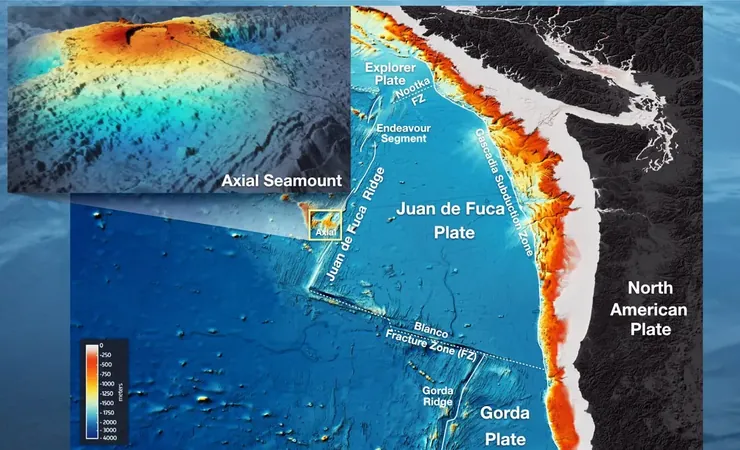
Underwater Volcano Off Oregon Coast Primed for Eruption: What You Need to Know for 2025!
2025-01-02
Author: John Tan
In a dramatic development beneath the waves of the Pacific Ocean, 470 kilometers from the Oregon coastline, the Axial Seamount is stirring with heightened volcanic activity. Expert geophysicist Bill Chadwick from Oregon State University warns that this incredibly active underwater volcano is gearing up for an eruption, possibly before the end of 2025! This forecast is backed by decades of meticulous monitoring and the unique volcanic behavior observed at Axial.
The Pressure is Building!
Chadwick describes the situation as a pressure cooker about to blow its lid. He shares insights from the recent 2024 American Geophysical Union meeting, stating, “Based on current trends, Axial will likely be ready to erupt once it hits the 2015 inflation threshold.” With a significant inflation rate increase noted in late 2023 and seismic activity skyrocketing to over 500 earthquakes a day by mid-2024, the volcano is certainly under intense pressure.
Renowned for its regular and predictable eruptive patterns, Axial Seamount has previously erupted in 1998, 2011, and 2015, showcasing a clear sequence of events: magma accumulation, rising pressure, and seismic activity leading to eruptions. This predictability offers researchers a unique opportunity to study this geological phenomenon extensively.
A Network of Surveillance
Mark Zumberge from the Scripps Institution of Oceanography emphasizes that Axial Seamount is the most comprehensively monitored submarine volcano globally. This intricate web of observation includes seafloor pressure sensors, autonomous underwater vehicles (AUVs), and remotely operated vehicles (ROVs), allowing scientists to capture unprecedented details about the volcano’s behavior.
Recent advancements, such as the full waveform inversion (FWI) seismic technique, have enabled researchers to generate high-resolution subsurface images. Astonishingly, they discovered a primary magma reservoir with melt fractions approaching 37%, indicating a volcano ready to mobilize magma for an eruption.
Why Should We Care?
While underwater volcanoes might not pose direct threats to human life, their eruptions can significantly impact marine ecosystems and may trigger tsunamis. The devastating eruption of Hunga Tonga in 2022 caused massive financial losses while highlighting the far-reaching consequences of such geological events.
As researchers aim to witness the impending eruption in real-time, volcanologist Rebecca Carey from the University of Tasmania sees immense value in understanding how the eruption might affect neighboring hydrothermal systems and ecosystems. These hydrothermal vents are home to unique marine life, holding vital clues on how biodiversity responds to volcanic disturbances.
A Leap Forward in Volcanic Forecasting
Innovations in artificial intelligence are leading to stronger predictive models for seismic data analysis, paving the way for more reliable eruption forecasts. Scientists strive to develop systems that could potentially forecast eruptions to the hour—an advancement that would revolutionize geological monitoring worldwide.
The significance of this research extends to our understanding of plate tectonics and crust formation. Axial Seamount's location at the junction of the Juan de Fuca Ridge and Cobb Hotspot reveals the dynamics of magma accumulation and release, vital in the formation of the oceanic crust.
A Learning Opportunity for the Future
The 2015 eruption, which unleashed a staggering 156 million cubic meters of lava, was pivotal in providing invaluable data to guide current monitoring efforts. Experts remain cautious, however, warning that Axial may behave unexpectedly despite its predictable patterns. Michael Poland from the U.S. Geological Survey reminds us that emerging patterns could lead to unforeseen volcanic activity.
As we look ahead to 2025, the Axial Seamount presents a golden chance to deepen our understanding of volcanic systems. Whatever the outcome, the revelations from Axial will likely resonate with scientists and researchers far beyond the ocean's surface, bringing us one step closer to understanding the mysteries of our changing planet. Will we witness nature’s fury in action? Stay tuned!



 Brasil (PT)
Brasil (PT)
 Canada (EN)
Canada (EN)
 Chile (ES)
Chile (ES)
 Česko (CS)
Česko (CS)
 대한민국 (KO)
대한민국 (KO)
 España (ES)
España (ES)
 France (FR)
France (FR)
 Hong Kong (EN)
Hong Kong (EN)
 Italia (IT)
Italia (IT)
 日本 (JA)
日本 (JA)
 Magyarország (HU)
Magyarország (HU)
 Norge (NO)
Norge (NO)
 Polska (PL)
Polska (PL)
 Schweiz (DE)
Schweiz (DE)
 Singapore (EN)
Singapore (EN)
 Sverige (SV)
Sverige (SV)
 Suomi (FI)
Suomi (FI)
 Türkiye (TR)
Türkiye (TR)
 الإمارات العربية المتحدة (AR)
الإمارات العربية المتحدة (AR)